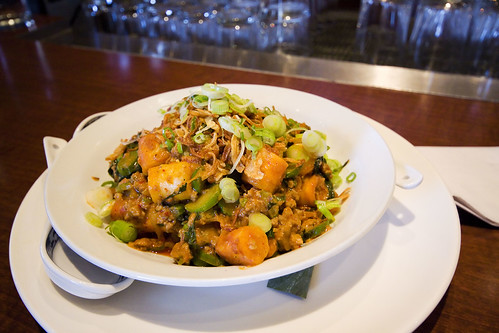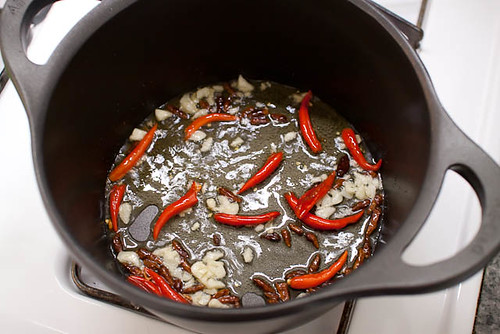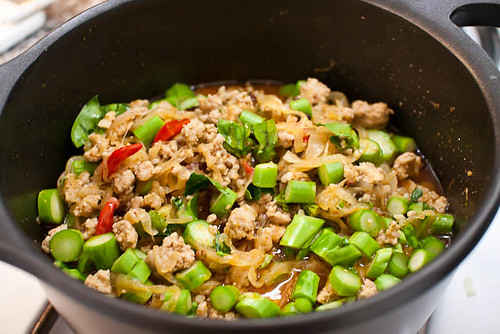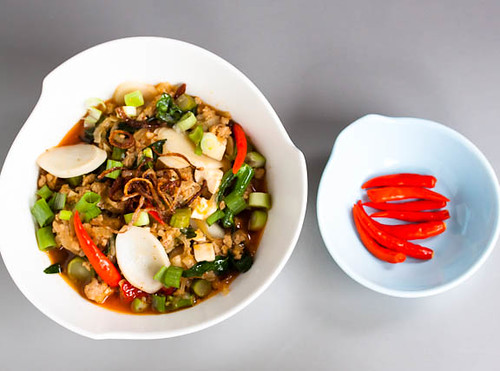Whenever I open a cookbook for the first time, I’ll usually skim the recipes with photos first. Are they appealing? Do they make me want to read the recipe? Do they make my mouth water and immediately start plotting out how I might make the dish, and soon?
Restaurant menus can be different. They often don’t have illustrations or photos accompanying the text, and the way a dish is described or written may have to work twice as hard to entice and lure and seduce.
Perhaps it’s because I was already familiar with them that the dishes I started out making from the Momofuku cookbook were those that we had already tried and ordered at the restaurant. There were some that I consciously set out the replicate: the Ramen, the Pork Belly, the Hamachi, the Pickles… and yet when I read the recipe for the Spicy Pork Sausage and Rice Cakes, it didn’t immediately dawn on me that we had sampled this dish, too, in the Ssam Bar, back in late 2009.
Origins
In the cookbook, David Chang indicates that the inspiration for the dish comes from Chinese Sichuan Cuisine – particularly of the very oily, spicy kind from a favourite hole-in-the-wall close to the original Momofuku Noodle Bar. Add in a melange of ingredients like Korean kochukaru (chile powder) and tteok (rice cakes) and you’ve got a quintessential Momofukian creation.
Heat
I used to be heat averse until I met DD, who does like and can take some heat in his foods. Just a couple of weeks ago I signed up for a weeklong intensive course in authentic Thai cooking with Kasma Loha-Unchit; a class requirement is to be able to tolerate heat at level 4 on a scale of 1-10. I think I’ve come a long way from shying away from all things spicy.
I think I might have seen this dish as a way to “practice” for those Thai classes, coming up a year from now.
What you may want to know about this dish is that it contains no less than 4 different kinds of spice: first, 2 cupfuls (!) of dried chiles (more on this later); then there’s some sichuan peppercorn and kochukaru and toban djan (Chinese chile sauce). A substitute Chang recommends for toban djang is Korean ssamjang – a seasoned bean paste.
Procedure/ Ingredients.
I won’t be reprinting the recipe here, but you can find it on the web in other locations: see Dineomite’s post, for instance; or here on the Boy Who Bakes. “Pork sausage” appears to be the equivalent of spicy ground pork in an oily chile sauce – you’re not using pre-made sausage. You’ll also need a number of items that may not be so easy to come by – I had most everything in my pantry, but did lack some items that were easily procured at Richmond New May Wah on Clement and 8th in the Inner Richmond, San Francisco. You’ll need:
- Dried Chiles: Chang doesn’t specify which kind to use.
- Kochukaru: Korean red pepper flakes.
- Toban Djan: Chinese bean paste made with fermented chiles and fava beans.
- Ssamjang (if you don’t have toban djan): Korean bean paste that usually contains the spicy pepper paste gochujang.
- Sichuan Peppercorns
- Tteok – Korean Rice Cake: Chang specifies the long, cylindrical kind, cut into bite-sized pieces. Like Steph at momofukufor2, we’re not crazy about the texture of these and instead used the thinner, diagonally-sliced oval-ish bits that look like these.
- Silken Tofu
- Ground Pork
- Yellow Onions
- Garlic
- Hearty leafy green, like Chinese Broccoli, or Gai Lan
- Green Onions
- 1/2 package of fried Shallots: not sure how large the package is for quantity’s sake. I just made my own. You can’t go wrong with fried shallot topping.
- Usukuchi (light coloured) soy sauce (not to be confused with “Lite” or “Low-sodium” soy).
- Salt, Sugar, Water, Neutral cooking oil (Chang recommends Grapeseed; I used Canola)
I did’t know quite what to make of the 2 cupfuls of dried chiles when I initially read the recipe. I then thought – “I’m not going to use 2 cupfuls. That’s crazy!” When I popped down to the market to get ingredients, I found a jar of vibrant red pickled thai chiles. I used about 11 of these slit down the middle and seeded; and about 1/8 cup of some tiny dried chiles we had at home. All in all this might have amounted to 1/2 cup of loosely packed pickled and dried chiles.
After caramelizing a lot of onions and browning the meat, you’ll bring together the chile ingredients (kochukaru, ssamjang, sichuan peppercorns, chiles) by sauteeing them with a lot of oil and garlic until fragrant.
Parboil your veggies (I might have skipped this step) and mix the onion, meat and chile sauce together. Chang notes that you can set aside/ freeze the pork and chile sauce (without veggies) for future ease/ speed of prep.
The remaining tasks include quickly boiling the tteok until warm, whipping the silken tofu until creamy/ fluid and adding them to the stew. I skipped whipping the tofu, cutting it up into small chunky bits instead – perhaps I should have. Dineomite notes that perhaps the creamy liquid tofu might have helped to tone down the heat somewhat.
Verdict
Ooooh, Spicy. Very, very very very spicy. But delicious and complex and hearty and mouth-numbing (in a good way)! The sichuan peppercorns were a delight – these are what will turn your mouth tingly, and tasted floral and herbal and minty-peppery. DD and I ate large bowlfuls each, sweating away, foolishly forgetting ignoring that we had planned our first official 5K run the next day. We had completed a “Couch to 5K” running program recently and wanted to run an official 3.1-miler as a goal. We were hurting in the morning, wondering whether we would make it to the race; thankfully we had risen early enough to get composed prior to the 9am start time. And we ran and somehow even achieved personal time records for that first race. Perhaps the chiles did help after all.
Post Recipe Thoughts. In the future…I will:
- use just dried chiles; not a mixture
- whip the tofu as directed
- not eat this before running a race – formal or informal – the next day.
Modifications
Over the next few days, we picked out the chiles whenever we reheated the stuff, serving over a great coconut and yuzu rice DD made. The cream from the coconut also helped tone down the heat. Once we also served the stew with a fried egg; this helped with the spiciness as well.
Ah, the Internets
For posterity and for kicks and for those of you out there who: 1) know DD, me and my girl Nora in real-life; 2) are on Facebook; and 3) are not afraid of the possibility of scatological references, here’s the conversation on race morning.






Pingback: Scallops, Uni and Mentaiko Squid Ink Pasta | Tabemasu()
Pingback: Excuses | Tabemasu()